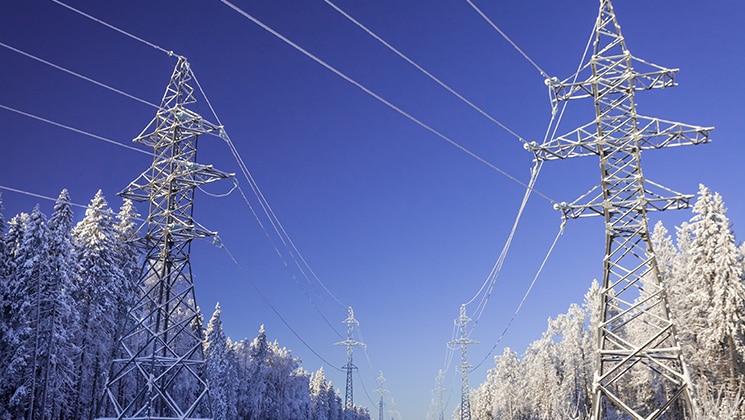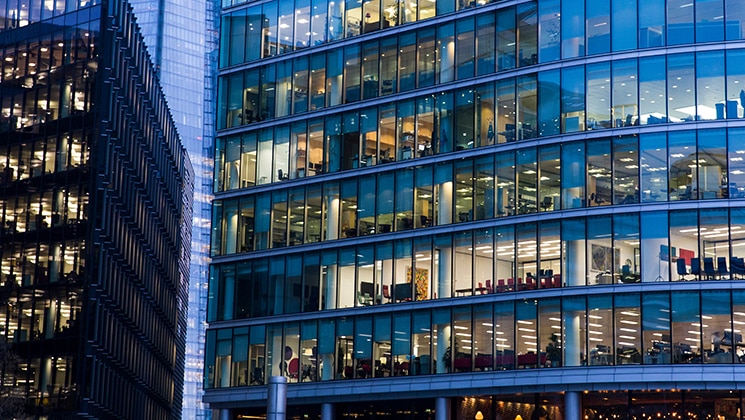
In 2021, we saw winter storm Uri hit Texas, leaving millions of people without power. We watched lines form at the gas pumps after hackers attacked the Colonial Pipeline, leading to a weeks-long fuel shortage along the Eastern Seaboard. And we saw millions of acres burn in California after a tree fell on transmission lines owned by Pacific Gas and Electric. Each of these incidents revealed the hard-to-swallow truth that America’s energy infrastructure is vulnerable — and areas with undermaintained or weak power grids are more likely to experience system-scale failures in the coming years.
“With the risk of long-term power outages on the rise, it’s critical for organizations in every industry to consider the impact of prolonged power loss on their business.”
With the risk of long-term power outages on the rise, it’s critical for organizations in every industry to consider the impact of prolonged power loss on their businesses. In this three-part article, we’ll share key risks you should consider as part of your enterprise risk-management program, how they impact different industry sectors, and strategies for a business continuity plan that can help you survive an outage.
Part I: The 5 major business risks of a power outage
It’s easy to think of a power outage as a temporary business continuity problem — but in many cases the impact goes way beyond closing your business for a few days. In fact, power outages can have a ripple effect, with lasting consequences for your entire operation. Here are five of the key risks you should consider ahead of an outage:
1. Property damage
Whether a power outage results from severe weather or a human-caused event, it can lead to property damage that impacts your business continuity — and your bottom line. If the heating, ventilation and air conditioning (HVAC) goes out, for example, extreme heat, cold, or moisture can cause permanent damage to walls, flooring, and equipment. And if power loss leads to food spoilage or product contamination, you may also lose inventory.
2. Equipment breakdown
Restarting equipment after an outage can be risky, particularly given that equipment was likely shut down incorrectly when you lost power. Your machines may have been damaged because of an improper shutdown, and they can also malfunction once the power comes back on. This can lead to other hazards, like the increased risk of employee injury, when workers have to restart equipment after an outage.
3. Failure to fulfill contracts
Along with the business interruption caused by a power outage comes the risk of being unable to complete contracts. Suppose you experience lasting damage to your property or equipment due to a power outage, for example. In that case, you may be held liable for failure to fulfill your contracts — which can have lasting consequences for your business. And while this risk may tempt business owners to return to work faster, that can be a mistake. Pushing employees to work in unsafe conditions to fulfill those contracts can cause other problems, like an increased risk of employee injuries.
4. Inventory risks
After a prolonged period of business interruption, companies may be inclined to rush out products to compensate for lost time. But that inventory is at a higher risk — particularly if companies use subpar materials because of supply chain delays. Companies that take a more rushed approach are at an increased risk for damaged or spoiled inventory. Without the right processes in place to dispose of products that don’t meet quality standards, they could end up on store shelves, causing further problems.
5. Environmental exposures
Finally, power outages may bring environmental exposures, like mold growth, oil accidents, and contamination from toxic substances that may have been improperly stored when the power went out. Companies can be held responsible for environmental damage caused by a power outage — plus, environmental risks may lead to property and inventory damage, as noted above.
Part II: How power outages affect specific industry sectors
While the five power outage risks outlined in Part I apply across industry sectors, there are other impacts that depend on a company’s specific operations, geographic location, and industry. In this section, we’ll take a closer look at the consequences of power loss in four different industries, along with key tips to mitigate risk.
“No one in Texas anticipated an ice storm. But infrastructure vulnerabilities, as well as increased risk for severe weather, can put your company at risk in ways you would never have imagined a decade ago.”
Manufacturing
Manufacturing companies have the potential to be severely interrupted after a power outage. They will likely experience delays delivering products, and they may undergo prolonged business interruption if their suppliers are also affected. There can also be considerable property damage after an outage if equipment wasn’t shut down properly, along with risk to employees if they return to work under unsafe conditions or are injured when restarting machines. Finally, manufacturers may experience long-term product liability concerns if they cut costs and corners to make up for delays or opt to replace their tried-and-true suppliers due to supply chain problems without going through their typical vetting process.
How to mitigate your risk: manufacturers need to have a comprehensive business continuity plan in place, with a specific plan of attack for how they are going to spin up operations after a power outage. This plan should consider which production machinery will be most impacted, as well as inventory spoilage and environmental concerns. It’s also important to consider potential supply chain delays during the planning process. Procurement managers should have three or four levels of backup suppliers in place that they can turn to if their typical supplies are out of commission. Larger companies might consider whether they can contract with another manufacturer to meet production needs, or plan for facilities in other regions to compensate for delays. Finally, business leaders should train employees on emergency shutdown and restart procedures to mitigate the risk of equipment damage and injuries after an outage.
Construction
In the construction industry, equipment damage and worker safety are the most significant risk areas after a power outage. In many locations, heavy machinery isn’t winterized because it’s either not used in the winter or temperatures tend to stay moderate all year. In the event of extreme cold snaps in otherwise warm climates, such as what Texas experienced during winter storm Uri, major new risks can surface once work restarts. For example:
- Local crane operators may not know that crane capacity needs to be derated in below-freezing conditions.
- The weather might damage tools that are stored improperly, creating safety hazards and delays.
- Warm-weather workers may not be trained to operate equipment in these hazardous conditions.
These risks and others can lead to damage to equipment, damage to the build site, and job site injuries.
How to mitigate risk: ensure that all workers are trained on proper protocols to operate equipment after an outage, or during harsh weather conditions. Employees should also be trained on how shifting weather conditions might impact building materials like concrete, which sets differently in cold temperatures. Wood can also introduce risk to a project if it grows mold or rots after being exposed to the elements. Contractors should also be aware of slip and fall hazards around the construction site — often, contractors are responsible for the premises around their job site too, which may include icy or slippery sidewalks.
Retail and wholesale distributors
During an outage, retailers and wholesalers are at an increased risk for product spoilage and inventory loss, even if they don’t deal with foodstuffs. Pharmaceuticals, medical devices, and other products can also be damaged or contaminated if there is prolonged power loss. If the outage is caused by extreme weather, companies may also need to worry about mold and environmental risks, such as toxic spills. Additionally, outages may lead to theft or vandalism — which may be particularly concerning if security systems are disabled due to power loss.
How to mitigate risk: retailers and wholesalers should have a contingency plan for product spoilage or inventory loss, including a process in place to recover lost inventory in the event of an outage. Additionally, to avoid the risk of product recalls, employees should be trained on proper procedures to inspect materials for mold, contamination, or spoilage. Finally, if companies operate in an area where theft, vandalism, or looting may be a risk, business leaders may want to consider hiring additional security to protect inventory during a power outage.
Hospitals
Hospitals, specifically inpatient facilities, are often the most prepared for a power outage, because they are required to have robust business continuity plans to cover a spectrum of contingencies. Most have plans to acquire backup power in an emergency, and they are also first in line to receive additional power resources if necessary. Despite these safeguards, however, some hospitals have experienced backup power failure after a major outage; this happened in Texas during winter storm Uri and in New York City during Hurricane Sandy. Additionally, hospitals may lose access to critical patient records during an outage, particularly as a result of a cyberattack.
How to mitigate risk: when people’s lives are at risk, there is no such thing as “too prepared.” Hospitals should have contingency plans in place for backup power failure, particularly now that we know regional power outages are a possibility. Healthcare organizations should also have disaster recovery services in place to ensure they will continue to have access to patient records after an outage; to put those plans in place, many organizations are migrating to the cloud.
Part III: Creating a power outage continuity plan
When it comes to power outages, by far the best mitigation strategy is thoughtful preparation. A company’s business continuity plan will be specific to its operations, industry, and location. However, our insurance experts have compiled some high-level guidance on how to think through different scenarios — even ones you think could never happen:
- Recruit an experienced planning team to analyze perils specific to your business or industry, develop a draft plan, test and implement that plan, and keep it updated as conditions change.
- Conduct job safety analysis by breaking down each job into tasks and steps. From there, you can identify potential hazards after an outage, and develop training and controls to mitigate risk.
- Identify specific threats to equipment or inventory. You should know ahead of time how long food lasts in your freezers, for example, and how your equipment responds to sudden shutdowns.
- Have a decentralized backup power supply in place to protect your company from prolonged interruption. Some companies rely on solar, while others opt for backup generators. It’s important to remember some generators may require you to store fuel on premises, which can also introduce new risks.
- Build strong relationships with your vendors to ensure timely service and repairs after an outage. You should also have backup vendors in place in case of widespread power loss. And make sure you ask to see your vendors’ continuity plans, as they might also be affected by the power loss.
- Have a process in place to document your losses. Should damage occur, having a plan in place to take photos and retain damaged parts will streamline your claims process.
- Work with your insurance carrier and broker to regularly re-evaluate your coverage and identify your exposures to prolonged or regional power outages.
When the lights go out, are you prepared?
Infrastructure vulnerabilities, as well as increased risk for severe weather, can put your company at risk in ways you would never have imagined a decade ago. In today’s world, businesses need to think outside the normal realm of possibilities — and your insurance provider is the best partner to help you do so. Your insurance partners can help you identify the unique risks your company may face during a power-loss event, and work alongside your team to create a plan to manage and mitigate that exposure — so that if the worst happens, your business is in the best possible position to recover and move forward.
Learn more about how Liberty Mutual supports businesses facing prolonged power loss and other risks that impact business continuity.
Related insights
This website is general in nature, and is provided as a courtesy to you. Information is accurate to the best of Liberty Mutual’s knowledge, but companies and individuals should not rely on it to prevent and mitigate all risks as an explanation of coverage or benefits under an insurance policy. Consult your professional advisor regarding your particular facts and circumstance. By citing external authorities or linking to other websites, Liberty Mutual is not endorsing them.


